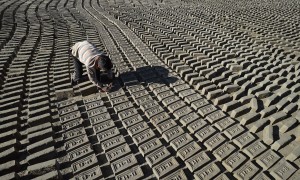Soft little young hands that actually should be writing and learning are usually forced to work in Nepal’s brick industry. Young children from the age of 5 sometimes suffer spinal injuries and lung cancer from carrying a heavy load of bricks and working in the brick kilns about 15 hours a day. But finally, towards the end of 2015 and hopefully by the beginning of 2016, a few projects plan to open, commercially, that hope to improve working conditions for young brick workers in Nepal.
In the next few months, the World Food Programme (WFP) plans to use the bricks from the Bhramhayani Mata factory to build a staging area for emergency supplies and support in Nepal, for when major disasters happen, claimed a report from February 2015. WFP’s project is being funded with £2million by Britain’s Department for the International Development (DFID) and is one of the three projects soon to be built.
Another brick project is the Fairfield by Marriott Hotel in Nepal’s capital, Kathmandu, which is proposed to open between the end of 2015 and the beginning of 2016. It’s reported that a small number of bricks from the Om Himalayan kiln, will be used in the hotel’s basement. A spokeswoman commented about the soon to be Marriott Hotel in Kathmandu. She said: “The owner and developer of the hotel is Nepal Hospitality Group Private Limited.” Apparently this hotel will be expanded in the next four years.
Back in March 2015, when Marriott Hotels International Limited signed a management agreement for the flagship Marriott Hotel to open, the Senior Vice President of hotel development, Navjit Ahluwalia said: “It is another important step in our expansion plans which will see Marriot International surpass 1 million rooms worldwide by the end of 2015 and more than double its size in Asia within the next four years.” About Rs.650million is expected to be invested in this hotel.
 So young brick workers, sometimes start their work at 1am even during Nepal’s freezing periods. A 14 year old young brick worker in Nepal, Prem Thing said: “I wanted to stay at home, but the broker brought me here.” Thanks to the young brick workers, Tribhuvan International Airport in Kathmandu has been upgraded with the bricks from the kilns. Recent reports claim the Asian Development Bank (ADB) funded this airport.
So young brick workers, sometimes start their work at 1am even during Nepal’s freezing periods. A 14 year old young brick worker in Nepal, Prem Thing said: “I wanted to stay at home, but the broker brought me here.” Thanks to the young brick workers, Tribhuvan International Airport in Kathmandu has been upgraded with the bricks from the kilns. Recent reports claim the Asian Development Bank (ADB) funded this airport.
Cold, warm or wet, thousands of young and older brick workers are forced into bonded labour, according to news reports. Probably, brick workers feel trapped. It is estimated that up to 28,000 children are working in brick kilns in Nepal and at least half of these children are under 14years.
But with more than 1,100 kilns operating in Nepal, it’s about time budding brick kiln workers are educated about the realities of getting stuck in labour work. Nepal’s government aims to educate more students about the possible risk factors involved when working in the brick industry.
Also the Global Fairness Initiative (GFI), which partnered with vulnerable working communities in Asia, Latin America and Africa plan to establish fair wages, put an end to poverty, generate opportunities and find economic solutions. Nepal’s country director for GFI, Homraj Acharya said: “We want to create standards for the industry to follow. If [the factories] meet the criteria then there should be benefits. They can become torch bearers for the change in the industry.”
Young brick workers clink away on the bricks as they build each project during Nepal’s dry months, November to May every year. Although some of these labour workers probably live in small brick shacks with an iron roof, their wages are very low. Sometimes labour workers have to ask for a loan in advance to pay off their previous debt. If brick workers don’t work during November-May, they end up paying a huge fee on their earnings. But the brick industry is increasing and labour workers are sometimes stuck in a vicious cycle.





















